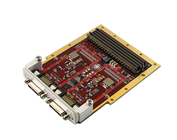
- FMC422 is ideally suited for high bandwidth deployments such as degraded visual environments, active protection systems and autonomous vehicles
- Includes comprehensive software support to minimize risk, time and cost of development
- Leverages Abaco’s state of the art FPGA board, carrier range
The FMC422 provides the optimum solution for new systems as well as a straightforward technology refresh/performance upgrade for existing systems. By taking advantage of the FMC422, users can also benefit from the latest FPGA boards from Abaco such as the VP880, a 3U VPX FPGA board featuring a Xilinx® Ultrascale™ FPGA and Zynq® Ultrascale+ MPSoC as well as Abaco’s extensive range of FPGA carrier cards.
“With the FMC422, customers can substantially minimise the time, cost and risk of developing mission ready systems for low latency video applications,” said Pierrick Vulliez, Vice President, Advanced RF and DSP at Abaco Systems. “Our complete single source solution significantly reduces integration risk, while the provision of a comprehensive support package lessens development effort, decreasing cost and time-to-deployment.”
By providing modular solutions that leverage proven interfaces, Abaco enables customers to refresh their legacy systems rather than having to completely re-architect them.
“Camera Link has been on the market for a long time, and its low latency and high bandwidth characteristics make it a dependable option for many video processing applications,” continued Vulliez. “However, monolithic video processing boards with Camera Link inputs can make it challenging to upgrade to the latest technology. Transitioning to the FMC422 and an FPGA board can enable tech insertion today, as well as provide a simpler path to future FMC module upgrades. This modular approach can also significantly mitigate the impact of obsolescence.”
The FMC422 offers three significant advantages when compared with alternative solutions.
Camera links up to and beyond the industry standard are provided by the FMC422, while Power over Camera Link (PoCL) reduces the requirement for customers to add power cables to their camera. Pairing the FMC422 with an FPGA carrier enables extensive support for legacy cameras as well as future products.
Software support includes Microsoft Windows® and Linux®; a board support package that includes an open source VHDL reference design and open source C/C++ reference examples; and Stellar IP, an FPGA tool to greatly simplify and speed system development.
More Information.
Whitepaper: Addressing the challenges of low latency video system requirements for embedded applications
By providing modular solutions that leverage proven interfaces, Abaco enables customers to refresh their legacy systems rather than having to completely re-architect them.
“Camera Link has been on the market for a long time, and its low latency and high bandwidth characteristics make it a dependable option for many video processing applications,” continued Vulliez. “However, monolithic video processing boards with Camera Link inputs can make it challenging to upgrade to the latest technology. Transitioning to the FMC422 and an FPGA board can enable tech insertion today, as well as provide a simpler path to future FMC module upgrades. This modular approach can also significantly mitigate the impact of obsolescence.”
The FMC422 offers three significant advantages when compared with alternative solutions.
- A direct LVDS connection to the FPGA. Older generation transceiver technology cannot operate with modern FPGAs.
- The potential to run at a faster data rate than the standard because of the direct connection to the FPGA.
- Customers can leverage Abaco’s extensive systems expertise as well as ease integration complexity by using one partner for multiple aspects of their system development.
Camera links up to and beyond the industry standard are provided by the FMC422, while Power over Camera Link (PoCL) reduces the requirement for customers to add power cables to their camera. Pairing the FMC422 with an FPGA carrier enables extensive support for legacy cameras as well as future products.
Software support includes Microsoft Windows® and Linux®; a board support package that includes an open source VHDL reference design and open source C/C++ reference examples; and Stellar IP, an FPGA tool to greatly simplify and speed system development.
More Information.
Whitepaper: Addressing the challenges of low latency video system requirements for embedded applications
